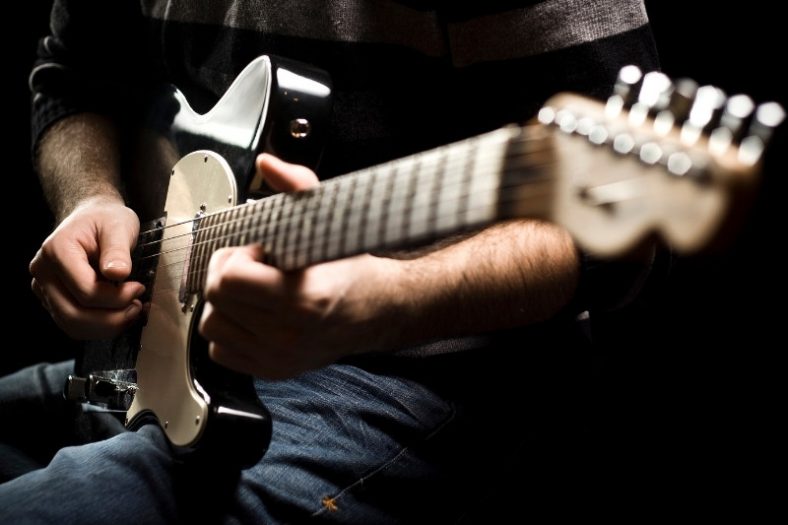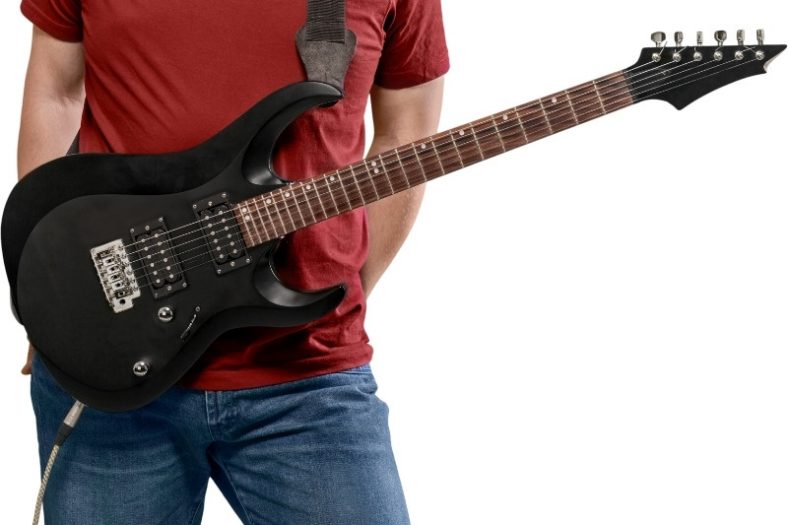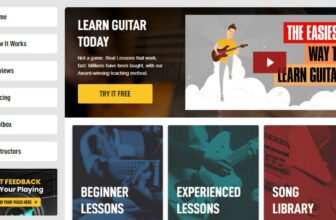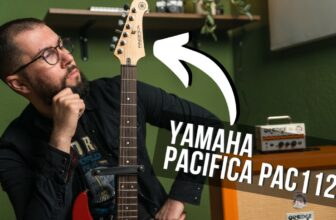How to Play Electric Guitar for Beginners (Easy Guide)

No matter what genre of music you want to play, here are some tips and tricks on how to play the electric guitar. Picking up a new skill can often seem intimidating at first, but don’t worry, we’ve got you covered! Read on to find out how you can start your electric guitar journey today.
Contents
- 1. Gearing Up
- 2. Holding Your Guitar
- 3. Tuning And Setting Up Your Amp
- 4. Anatomy Of The Electric Guitar
- 5. Learning Scales And Music Theory
- 6. Playing Basic Chords
- 7. Playing Technique
- 8. Taking Lessons: Private And Online
- 9. Teaching Yourself Guitar
- 10. Setting Up A Practice Schedule
- Easy Songs To Play On The Electric Guitar:
- Expanding Your Musical Preferences
- Training Your Ears
- Go At Your Own Pace
- Conclusion
1. Gearing Up
To play electric guitar like a pro eventually, everyone needs to start somewhere. The first step is to have the necessities such as a guitar, an amp, an instrument cable, and accessories such as a pick (plectrum) and a guitar strap.
Beginners often make the mistake of buying very expensive gear when starting. The truth is, you don’t need top-of-the-line equipment to sound good. The magic is all in your fingers. So start small, invest in a relatively cheaper guitar and amp. Keep in mind that you can always upgrade as you grow out of your gear.
When it comes to accessories such as the pick, buy a few different ones to see which one you feel most comfortable using. Typically, thinner picks are used for strumming and thicker ones for playing lines and solos. Medium picks are always a good bet because they offer the best of both worlds.
Brands such as Squier and Epiphone have great beginner, budget-friendly guitars. Choose a model that you feel comfortable holding and moving your fingers around. As for the amp, you can always start with a small 10W one. Although these are small in appearance, they will help you hear yourself clearly and keep the complaints from neighbors low.
2. Holding Your Guitar

Now that you have your gear in place, the next step is to know how to correctly hold your guitar. You may have noticed many punk and grunge guitar players hanging their guitars quite low, but this is not ideal for beginners. Adjust your strap so your guitar’s body rests comfortably between your chest and stomach. This will help you move around the fretboard with ease.
Another factor to keep in mind is to practice sitting upright or even standing up without slouching forwards or back. Be mindful of your posture in the initial stages of learning guitar. We will come back to why later in this article.
You will notice that over time, how you hold your guitar will change. But when you are beginning your guitar journey, don’t worry about physical appearance and looking cool. All of that will happen on its own eventually. Make sure that your dominant hand can grasp the neck comfortably and you are not weighed down by the body.
3. Tuning And Setting Up Your Amp
The standard tuning for an electric guitar is in ‘E’. This means that going from the thickest (6th) to the thinnest (1st) string, your tuning should be E, A, D, G, B, E. When you are buying accessories for your guitar, make sure you include a tuner in the list as well. You can read all about tuning and tuners here.
The reason why it is very important to learn how to tune your instrument before you learn how to play is that during this period you are not only developing new motor skills but also training your ears. You need to be able to tell a tuned guitar from a detuned one.
A good way to practice tuning by the ear is to detune all the strings but the higher (1st string) ‘E’ and then use your ears to try the tune the rest. You can always check how accurate you are with the help of a tuner and this can be a fun game to play with yourself from time to time.
Of course, tuning by the ear is an acquired skill and takes time to develop. But for the initial period, make sure you tune-up before you start your practice. Developing this habit early on will be very beneficial in the future.
No matter what brand or model of amp you have, they all have the same basic features and controls. Set your master volume to an appropriate level. You should be able to hear yourself clearly but it should not be so loud that it hurts your ears. Initially, you can set controls such as treble, middle, bass to 50% (12 o clock position) and make adjustments depending on what sounds good to you.
Don’t be afraid of experimenting with the controls of your amp. Play around with the different knobs in your free time to understand which one does what to the sound.
For practice, the sound should be clean, and although you may feel the urge to add effects such as delay and overdrive, remember that you need to master the clean sound before you move on to contouring your tone.
4. Anatomy Of The Electric Guitar
One of the secrets to becoming a great guitar player is knowing your instrument thoroughly. This includes a working knowledge of all the different parts of the guitar and why they are there. While you will be familiar with the basics such as the neck, the fretboard, the body, etc., you also need to know about the pickups and the different knobs on your guitar.
While different models have different knob configurations, learn more about guitar knobs and how they affect the sound of your guitar here.
Knowing the different parts of the guitar will also help you identify problems you might run into such as fret buzz and high action. If possible, print out a diagram labeling the parts of the guitar that you have and place it somewhere you can see regularly. This will imbibe the information in your brain even when you’re not playing or holding your instrument.
5. Learning Scales And Music Theory

While you don’t need to be an expert at sheet reading to play good guitar, you need to have a basic knowledge of music theory to be able to play guitar. The first step would be to start memorizing the notes on your fretboard.
We know that the primary notes on a guitar are E, F, F#, G, G#, A, A#, B, C, C#, D, and D#. This means that no matter what fret or string, it will always be one of these notes. While it is not possible to remember all the notes in one go, start small. Memorize the notes on the dotted frets such as 3, 5, 7, 12, etc. This will help you fill up the blanks in between.
Once you have an understanding of what note is located where you are ready to move on to scales. Scales are important because they help in music composition and performance. While we all want to play chords, understanding how scales work makes it easy to play chords. As a beginner, you might feel intimidated by all the scales out there but don’t worry. You can start with the chromatic scale and then move on to the majors and minors.
Practice the chromatic scale on your fretboard. This will help your fingers move across the fretboard with ease. Although this step may feel excruciatingly boring at first, it is important to persevere.
6. Playing Basic Chords
A ‘chord’ is a harmonic set of notes that are derived from a musical scale. On an electric guitar, some chords such as ‘E’, ‘Em’, ‘A’, ‘Am’, etc can be played in the open or ‘nut’ position while some need a ‘barre’ over them.
In a barre chord, the index finger presses down over all the strings to transpose the tuning of the guitar. Barre chords tend to feel difficult to hold at first but as your finger strength develops, you will find it easy to hold them for long periods.
Knowing how to play chords is highly satisfactory because it is at this point that you can start picking up easy songs to play and sing along to. But more on that later.
7. Playing Technique
Just like holding your guitar correctly, it is also important to adopt the correct playing techniques as a beginner. An improper technique not only brings discomfort but can also have harmful effects on your body if continues long-term.
As you develop skills to navigate around the fretboard, don’t ignore the strumming hand. Different genres call for different kinds of strumming. While funk rhythm will involve a lot of wrist movement, playing arpeggios and lines will require you to move around the strings with ease.
Practice dedicated rhythm exercises and be mindful of moving your wrists instead of your elbows. You will also notice how you hold your pick affects the tonal quality of the sound.
8. Taking Lessons: Private And Online

Although many guitar players are completely self-taught, having a teacher is always better because they can correct your form, monitor your progress, and guide you during the initial stages.
While private lessons can be expensive, they are ideal because your teacher will be able to help you identify your strengths and weaknesses. If you don’t have a budget for lessons, you can always ask a musician friend to give you lessons.
If you don’t have friends who play the guitar, look around for local guitar players whose music you enjoy. Most musicians love to teach and you’d be surprised by how easily they say yes if you just ask them nicely.
If you can develop a habit of regular and dedicated practice, you don’t necessarily need weekly lessons. You can set up a masterclass every month or fortnight, depending on what is convenient to you.
For those who do not have access to a guitar teacher near them, you can look up websites such as Fiverr, Upwork, etc for teachers who teach online. For this, you will need a good internet connection and a computer/mobile phone.
Additionally, there are also apps and websites which offer paid and free lessons. Yousician, Fender Play, the Gibson App, Ultimate Guitar, and Guitar Tricks can all be accessed online and you can use whichever one works best for you.
9. Teaching Yourself Guitar
Professional guitar players will tell you that you don’t need to go to an expensive music school to play good guitar. Thanks to all the technology available to us today, one can learn at their own pace in an environment they are the most comfortable in.
YouTube is probably the biggest example of this. There are numerous channels on playing electric guitar. Do a little bit of research to find a channel whose teaching method and lessons you find the easiest to comprehend and follow. It is recommended that you pick a channel that teaches you the basics first and then you can simply search for how to play a particular song.
It is important to note that if you are teaching yourself, you make it a point to adopt the correct playing techniques and posture when you practice. If you have a friend who is also interested in learning how to play guitar, work out a system where you practice together. That way you will be able to correct each other as needed.
Along with lessons on YouTube, pick up copies of books such as the ‘Hal Leonard Guitar Method’, ‘The Guitar Handbook’ by Ralph Denyer, etc. These will introduce you to music theory and you will develop an understanding of how scales, modes, chords, etc work. You will thus be able to not only play music but also compose it using your electric guitar.
10. Setting Up A Practice Schedule
Like anything in life, practice makes perfect. The more time you put in at the beginning, the greater the reward. There is a common tendency for beginners to spend an entire day practicing scales and then completely abandoning their practice for the next few. Know that consistency is key.
Instead of going overboard in one day, practice for shorter durations but every day. When you first start playing, you will notice that your fingertips will develop calluses, this is completely normal. Fight through the pain and break up your practice into shorter durations throughout your day.
It is very important to practice because you are developing new skills. You want the movement of your fingers to become muscle memory.
Another important thing to keep in mind is to use a metronome when you practice. You will observe that many people can move their fingers very fast around the fretboard but they have no sense of timing.
To avoid this, you need to develop a sense of rhythm early on. Practice playing to a slower bpm and gradually increase the tempo as you start getting more comfortable. You don’t necessarily need to buy a physical metronome, there are many free apps such as GuitarTuna, which can be downloaded onto a phone or a tablet.
Easy Songs To Play On The Electric Guitar:
Picking up songs is not only rewarding but also a good way to sharpen your skills. Here are a few great songs for beginners that you can play along to:
- Knocking On Heaven’s Door-Guns N’ Roses
While Slash is known for his approach to solos, the chord structure of this song is simple and gives you a lot of room to improvise arpeggio patterns, especially during the intro and the verses.
- Zombie-The Cranberries
This one is another 4-chord song that can be played by those who aren’t used to holding barre chords yet. But if you are able, you can always switch to power chords (5ths) during the chorus to give it a boost.
- Smoke On The Water-Deep Purple
The opening riff of this song is often considered a rite of passage for guitar players and is a great exercise in playing riffs as a beginner.
- Smells Like Teen Spirit- Nirvana
The great thing about this song is that it is fast and incorporates the same chords throughout the song. If you have trouble playing the exact rhythm pattern of the main riff, you can simplify it.
- Californication- Red Hot Chilli Peppers
For those looking to play arpeggios, then is a great song to pick up. The verses often sound complicated because of Flea’s bassline but if you listen to John Frusciante’s guitar parts closely, you will understand that apart from the solo, it is a relatively easy song to play.
Expanding Your Musical Preferences
Another thing seasoned guitar players will tell you is that they listen to all kinds of music, even to genres they don’t necessarily like. While there is no doubt that blues and jazz are the root of most music today and have evolved into many new genres, it is important to step outside your comfort zone from time to time.
If you like to play metal, you should listen to funk guitar players to learn and understand their rhythm techniques. Inversely, if you are a funk enthusiast, you should listen to metal to understand the impact of alternate (dropped) tunings on not just the playing and the overall sound.
While you will always have your favorite genres, it is important to learn from as many genres of music as you can. Jazz might feel intimidating or boring to listen to at first, but it is a good practice to train your ears. We will come to that bit in the next section.
Training Your Ears

When you play guitar, you use your ears more than your hands. It’s true. You can move your hands as fast as you want, but to understand whether you are playing well or badly, you need to teach your ears to listen to the music.
As part of practice, dedicate a portion of your time to listening to music. Try to analyze it as a musician and then hear it again as just a mere listener. The more your skills develop, the harder it will get to do the latter. Introduce yourself to different and new genres of music regularly.
Develop the habit of listening to albums in their entirety instead of singles on a playlist. This will also help you develop composition skills. The more music you expose yourself to, the bigger your repertoire will be and the more you will be able to understand music theory.
Apart from trying to tune your guitar by ear, try to pick up your favorite song by listening to it instead of looking up the tabs or chords online. You can slow it down or listen to it multiple times if you don’t get it right away. But this will help you sharpen your hearing and as a result of it, you will be able to play better.
Go At Your Own Pace
Playing guitar is supposed to be a fun thing, at the end of the day. There will be times when you feel frustrated and will want to give up, but you need to keep at it. Remember that you are not in competition with anybody and the most important thing is that you are having a good time on your guitar journey.
Set goals and monitor your progress periodically. You may breeze through certain aspects of learning and struggle with some. This is very natural because all of us have our unique strengths and weaknesses. Don’t try to rush and skip some steps because once you have all your fundamentals in order, playing guitar will become infinitely easier.
Discipline is a very important factor. Even if your guitar idol is someone who partied hard and had a lifestyle of debauchery, the truth is that they’ve spent a whole lot of time in their early years practicing their instrument with a lot of dedication to achieve greatness. So put in the effort, be consistent and take your time with it.
Conclusion
When we play guitar, we can express ourselves in ways words often fall short of. It is an incredibly enriching experience. The great thing about the guitar is that there is no age limit for learning. Whether you are 5 or 75, anyone can play guitar if they put in the time and the energy.
An electric guitar is a very versatile instrument and no matter what genre of music you want to be able to play. So don’t contemplate any longer. Pick up your instrument and start your journey today!





